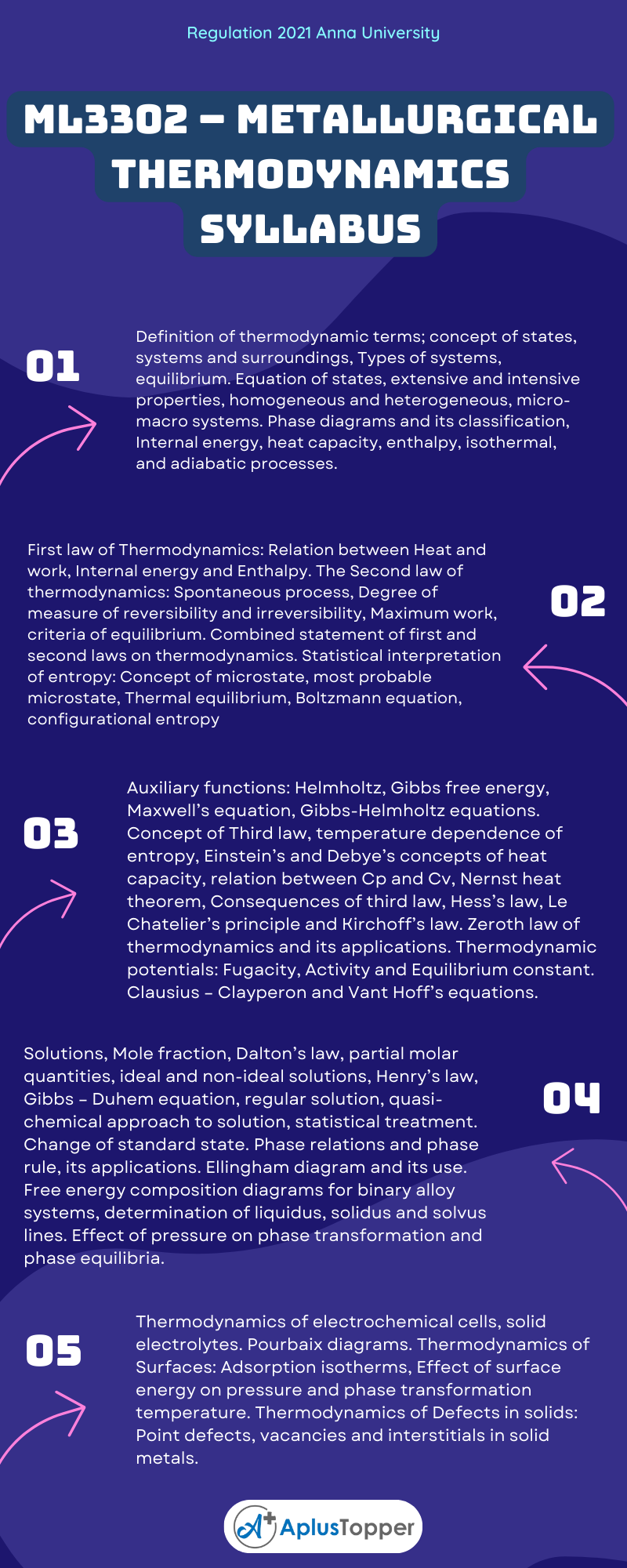Metallurgical Thermodynamics is the subject of semester III of Anna University B.E Material Science And Engineering Syllabus. In this article, we are glad to provide the syllabus of metallurgical thermodynamics part of Semester III Subjects in the first-year course.
We intend to provide the subject code ML3302 – Metallurgical Thermodynamics syllabus based on regulation 2021 by Anna University. You can get an idea of the topics in the syllabus of metallurgical thermodynamics. We hope that the absolute idea on the syllabus will assist the students in avoiding confusion of revision according to weightage. We also include required textbooks and references. If you require anything regarding the syllabus you can comment in the below section. Hope you like this information. Don’t forget to share.
If you want to know more about the syllabus of B.E. Material Science And Engineering connected to an affiliated institution’s four-year undergraduate degree program. We provide you with a detailed Year-wise, semester-wise, and Subject-wise syllabus in the following link B.E. Material Science And Engineering Syllabus Regulation 2021 Anna University.
Aim Of Objectives:
The main learning objective of this course is to prepare students for:
- Having an overview on the fundamental concepts in metallurgical thermodynamics
- Gaining knowledge about the state functions such as internal energy, entropy and criteria of equilibrium.
- Getting an insight to the auxiliary functions, heat capacities and thermodynamic potentials.
- Knowing the essentials of thermodynamic behaviour of solutions.
- Having an exposure on thermodynamics of electrochemical cells, surfaces and defects.
ML3302 – Metallurgical Thermodynamics Syllabus
Unit – I: Fundamental Concepts
Definition of thermodynamic terms; concept of states, systems and surroundings, Types of systems, equilibrium. Equation of states, extensive and intensive properties, homogeneous and heterogeneous, micro-macro systems. Phase diagrams and its classification, Internal energy, heat capacity, enthalpy, isothermal, and adiabatic processes.
Unit – II: Internal Energy And Entropy
First law of Thermodynamics: Relation between Heat and work, Internal energy and Enthalpy. The Second law of thermodynamics: Spontaneous process, Degree of measure of reversibility and irreversibility, Maximum work, criteria of equilibrium. Combined statement of first and second laws on thermodynamics. Statistical interpretation of entropy: Concept of microstate, most probable microstate, Thermal equilibrium, Boltzmann equation, configurational entropy
Unit – III: Auxillary Functions And Thermodynamic Potentials
Auxiliary functions: Helmholtz, Gibbs free energy, Maxwell’s equation, Gibbs-Helmholtz equations. Concept of Third law, temperature dependence of entropy, Einstein’s and Debye’s concepts of heat capacity, relation between Cp and Cv, Nernst heat theorem, Consequences of third law, Hess’s law, Le Chatelier’s principle and Kirchoff’s law. Zeroth law of thermodynamics and its applications. Thermodynamic potentials: Fugacity, Activity and Equilibrium constant. Clausius – Clayperon and Vant Hoff’s equations.

Unit – IV: Thermodynamics Of Solutions
Solutions, Mole fraction, Dalton’s law, partial molar quantities, ideal and non-ideal solutions, Henry’s law, Gibbs – Duhem equation, regular solution, quasi-chemical approach to solution, statistical treatment. Change of standard state. Phase relations and phase rule, its applications. Ellingham diagram and its use. Free energy composition diagrams for binary alloy systems, determination of liquidus, solidus and solvus lines. Effect of pressure on phase transformation and phase equilibria.
Unit – V: Thermodynamics Of Reactions
Thermodynamics of electrochemical cells, solid electrolytes. Pourbaix diagrams. Thermodynamics of Surfaces: Adsorption isotherms, Effect of surface energy on pressure and phase transformation temperature. Thermodynamics of Defects in solids: Point defects, vacancies and interstitials in solid metals.
Text Books:
- David R Gaskell & David E Laughlin,” Introduction to the Thermodynamics of materials”, CRC Press, Sixth edition, 2017.
- Subir Kumar Bose & Sanat Kumar Roy, “ Principles of Metallurgical Thermodynamics”, Universities Press, 2014.
References:
- Ahindra Ghosh, Textbook of Materials and Metallurgical Thermodynamics, Prentice Hall of India, 2002.
- Boris.S. Bokstein, Mikhail I. Mendelev, David J. Srolovitz,” Thermodynamics and Kinetics in Materials science”, Oxford University Press 2005.
- Prasad, Krishna Kant, Ray, H. S. and Abraham, K. P., “Chemical and Metallurgical Thermodynamics”, New Age International, 2012.
- Shamsuddin M, “ Physical Chemistry of Metallurgical process”, John Wiley, 2016.
- Upadhyaya, G. S. and Dube, R. K., “Problems in Metallurgical Thermodynamics and Kinetics”, Pergamon Press, London, 1977.
Related Posts Of Semester – III:
- MA3351 – Transforms and Partial Differential Equations
- ML3301 – Polymer Science and Engineering
- ML3391 – Mechanics of Solids
- ME3351 – Engineering Mechanics
Must Read:
